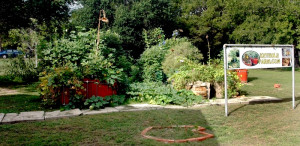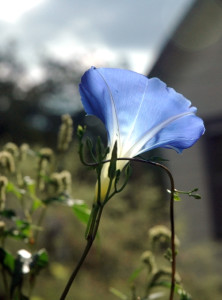 This update is posted on Oct. 5 and includes September information. We all know that keyhole gardens are intended to raise crops for human consumption. I am not a flower person (except sunflowers) by nature, but this year deci
This update is posted on Oct. 5 and includes September information. We all know that keyhole gardens are intended to raise crops for human consumption. I am not a flower person (except sunflowers) by nature, but this year deci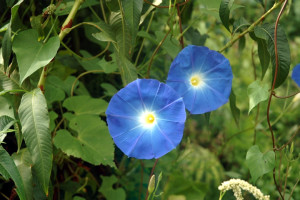 ded to intermingle some morning glory and other varieties in my gardens. During the past six weeks especially, they have really bloomed and have added a new dimension and resplendent color to my keyholes.
ded to intermingle some morning glory and other varieties in my gardens. During the past six weeks especially, they have really bloomed and have added a new dimension and resplendent color to my keyholes.
I planted them in early spring and since nothing much came of it, I had lost track of them. Then, in the hottest part of summer, they started blooming and have continued to add new flowers almost daily, which could in a way be helping my overwhelming okra crop this year since bees have also come back, after being down in number in early summer.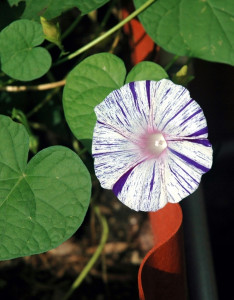
The images on this update contain mainly some flower photographs. Just click on the small image to enlarge. The flowers are continuously stretching their vines through various plants, including okra, Pennsylvania smartweed, and up some old sunflower stalks. I had pulled most of my sunflowers mid-summer but left a few in the keyhole gardens for birds to not only light on but to also feast on, thinking that while they are there, they might like to bring a degree of concern to the grasshoppers that happen by.
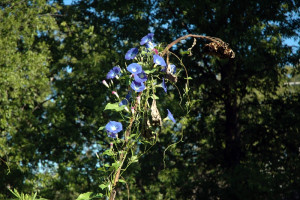 Each of these “glories” have their own personality. The smaller ones are pink, purple, blue, white, and striped. The bigger ones are blue and are quite spellbinding up close.
Each of these “glories” have their own personality. The smaller ones are pink, purple, blue, white, and striped. The bigger ones are blue and are quite spellbinding up close.
Right now, my most abundant crops are okra (it takes about 30 minutes to pick them each day) that are growing like crazy, watermelons (both red- and yellow-meated varieties), and tomatoes (both large and small).
Last month I thought my black-eyed peas had quit making and was planning to pull them. When I didn’t get around to it, they started making peas again, so I am giving them a little more time. I also have banana melons, cantaloupe, carrots, Swiss chard, gourds, and a few other experimental crops erupting from my gardens.
I p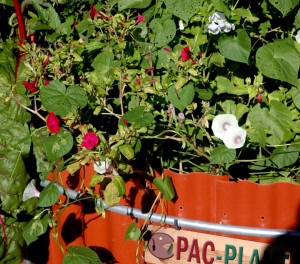 lan to harvest some of the morning glory seeds and replant next year. I never dreamed they would be as impressive as they are.
lan to harvest some of the morning glory seeds and replant next year. I never dreamed they would be as impressive as they are.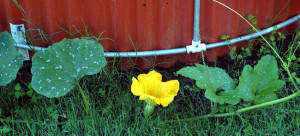
Keyhole gardens are still gaining in popularity, partially because they take very little water when the internal basket is used to the hilt, which also helps provide useful nutrients for the garden, the natural way. They conserve water, require little weeding, and crops can be planted very close together.
I had one of my daughters pick okra the other d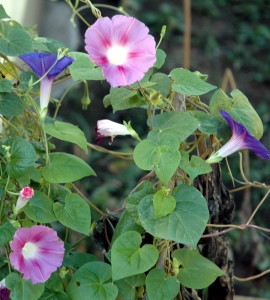 ay. She described the excursion as “entering a forest” as she pulled down the stalks so that she could access the fruit. It is a lot like a miniature forest as thick as the crops are, but it’s fun to do. I pick the tomatoes when they start to turn orange. That, too, takes some exploration as thick as the plants are.
ay. She described the excursion as “entering a forest” as she pulled down the stalks so that she could access the fruit. It is a lot like a miniature forest as thick as the crops are, but it’s fun to do. I pick the tomatoes when they start to turn orange. That, too, takes some exploration as thick as the plants are.
I have a few watermelons growing inside the keyholes, but most have overflowed and the melons are spread out on the ground, which is the 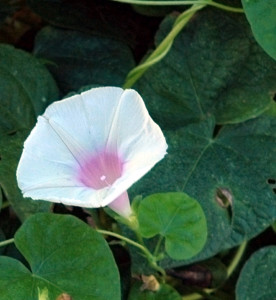 way the gourds have grown. I have one watermelon that is leaning right next to a keyhole garden, but it came from an adjacent keyhole.
way the gourds have grown. I have one watermelon that is leaning right next to a keyhole garden, but it came from an adjacent keyhole.
One thing about keyhole gardens is that you can almost see the crops growing. One day they are a certain size, and 24 hours later you can see the growth that has transpired.
If you would like to order a keyhole garden kit that’s easy to assemble and fairly easy to move, please click on the appropriate selection on the bar above.
I have just added two additional keyholes to our farm, which makes nine at this time. Our oldest one is in its sixth year, so the timetable for durability is still advancing.
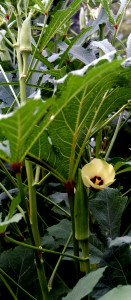 You can actually enjoy keyhole gardens better than traditional gardens because you can easily get closer to the plants (the backbreaking work element is virtually eliminated).
You can actually enjoy keyhole gardens better than traditional gardens because you can easily get closer to the plants (the backbreaking work element is virtually eliminated).
My youngest daughter is in college majoring in anthropol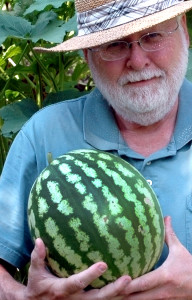 ogy. She mentioned that her class has been studying the theory of evolution as proposed by Darwin. I said, “That’s nice. Of course, it is filled with errors.” After a pause, I added, “Man did not evolve from monkeys. If he evolved from anything, he evolved from plants. Think about it.”
ogy. She mentioned that her class has been studying the theory of evolution as proposed by Darwin. I said, “That’s nice. Of course, it is filled with errors.” After a pause, I added, “Man did not evolve from monkeys. If he evolved from anything, he evolved from plants. Think about it.”
Actually, it is quite easy to develop a friendship with plants. As much time as I spend in keyhole wonderland, it is interesting to realize that the life-cycles and development of crops is really a whole new world to explore. To me, everyone should have that opportunity.